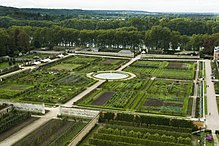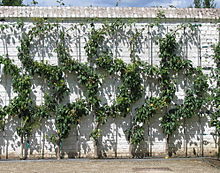Form fruit growing
The shape of fruit growing is a type of fruit growing in the branches of trees are conducted through targeted cuts and binding measures in a particular habit. A trellis is often used for this .
History of shaped fruit growing

Form fruit growing began in France, where it was already widespread in the 17th century. The first mention in French horticultural literature is from Boyceau de la Barauderie. Form fruit growing from France first spread to Belgium, the Grand Duchy of Luxembourg and Alsace-Lorraine.
Impressed by the extensive orchards in the Potager du roi , the royal kitchen garden at Versailles Palace , which were laid out by court gardener Jean-Baptiste de La Quintinie between 1678 and 1683 , numerous German aristocrats tried to emulate this model in the 18th century and let court gardeners in Train France in the technique of shaped fruit growing. The attempts at cultivation in Germany mostly failed because it was not possible to adapt the fruit cultivation to the German climatic conditions.
In the years 1862–1864, the French gardener and fruit grower Alexis Lepere , together with his son Alexis Lepere the Younger, laid a trellis garden, the so-called Lepère'schen Quartiere, for King Wilhelm I in the Babelsberg court garden and on the royal vineyard on Klausberg in Sanssouci on. In his tree nursery in Montreuil, Lepere had developed the Lepère walls named after him for the peach culture, which he had already tested in Versailles, Basedow and Arendsee (Brandenburg) for peach cultivation.
The south-facing systems enabled an early and longer growing season for peaches, apples , pears and cherries . Nevertheless, the plan to supply the farm with fruit from its own cultivation all year round failed because of the German climate.
After the Franco-Prussian War , Nicolas Gaucher promoted shaped fruit growing in Germany. The French gardener, who had learned from Du Breil in France, among others, came to Stuttgart in 1869 as a nursery nurse and founded his own fruit nursery in 1872. Gaucher published several books on fruit growing, in which he also dealt with the technique of shaped fruit growing. He laid out trellis gardens all over the country and is considered to be the founder of shaped fruit growing in Germany. By translating his books into Russian, he also had a significant impact on fruit growing in Russia.
The pomological institutes and educational establishments in Reutlingen , Proskau , Wildpark near Potsdam , Geisenheim , Augustenberg, Heldwigsberg and Kassel, who maintained model plants and trained their students in the appropriate cutting technique , also made a significant contribution to the successful spread of shaped fruit growing in Germany . In addition, numerous German tree nurseries were now able to grow espalier trees themselves, while the trees had previously been almost exclusively imported from France and Belgium.
The upbringing of the shaped fruit trees requires practical and theoretical knowledge of fruit tree pruning and time-consuming, regular pruning and care measures. For this reason, shaped fruit growing was not very widespread among the fruit-producing rural population and was mainly applied to manorial and upper-class estates and gardens . Overall, less research was done in fruit growing and the few new findings were implemented more slowly than in other farming . The reasons for this are the more difficult rationalization and mechanization of fruit growing and the more difficult transport of the goods due to the faster perishability .
Only at the beginning of the 20th century did this change and the old knowledge of shaped fruit growing was adapted in order to force a rational management of the fruit stock. The realization of the better management of the trees, which came from the form of fruit growing, by means of weak-growing, shorter trunk bases , was further promoted during the Nazi period to achieve self-sufficiency .
Goals of shaped fruit growing
The aim of shaped fruit growing is to be able to grow fruit in a small space. The branches of the fruit trees are specifically directed into certain growth forms in order to use the available space, e.g. B. on a wall, as effectively as possible. At the same time, the formation of flowers is induced by a horizontal branch position, which means that the yield of shaped fruit trees starts early.
Form fruit trees are often drawn to walls. These store heat, which they slowly release again and at the same time protect against cold wind and drafts, which creates a microclimate that is favorable for the fruit trees. This makes it possible to cultivate sensitive and climatically demanding, warm fruit species and varieties with a longer cultivation time. Form fruit cultivation was therefore particularly widespread in the cultivation of pears, vines, peaches and apricots, today also in kiwi cultivation. The aim is not to have a high number of fruits per tree, but to harvest high quality and well-ripened fruits.
The small shaped fruit trees were also often cultivated in planters. Exotic fruits could be housed in orangeries all year round or during winter .
Multi-variety trees are often cultivated in shaped fruit growing. The individual leading branches are refined with leaflets of different varieties, which makes it possible to cultivate and harvest several varieties of one type of fruit at the same time on a small cultivation area.
Especially in the manorial and upper-class gardens, the shaped fruit trees were cultivated and used as a garden design element because of the decorative value of the growth form, the blossom and the fruit hanging. Today shaped fruit trees are often cultivated in house and allotment gardens, as there is only limited space available here.
Cutting and culture measures
In the form of fruit growing, weakly growing rootstocks are usually used to limit the vigor of the trees and to achieve an early start of yield. Should larger areas, e.g. B. a whole house wall, are overgrown, but also strongly growing documents are used.
The leading branches of the trees are guided in the desired direction by cutting and binding measures. To tie the young branches, trellises, scaffolding, wire frames or so-called palissure sticks are used, which keep the young and still elastic branches in the desired direction of growth. The tree pruning usually takes place in summer, which should have a calming effect and promote yield. The aim of the pruning measures is to stimulate the tree to form short fruit wood and to ensure that the fruit is well exposed to the sun through the positioning of the branches.
A special cultural measure in shaped fruit growing is pinching , whereby the tip of the still herbaceous shoots is removed. This keeps the individual branches in balance by slowing down the growth of the treated shoots. The plant is stimulated to increase the formation of flower buds from wooden eyes.
Artful tree shapes were developed especially in the 19th century. Shaped fruit trees can be raised as vertical cord trees, as spindles, as one or two-armed cordons (with a horizontally growing trunk extension) or in a U-shape (e.g. around a window cutout on a wall). In the palmette forms, horizontal or inclined leading branches are alternately directed to the right and left. In addition to these two-dimensional forms, there are also three-dimensional growth forms such as the kettle tree or the wing pyramid.
Examples
Web links
Individual evidence
- ↑ J. Boyceau de la Barauderie: Traité du jardinage selon les raisons de la nature e de l'art. Paris 1638, pp. 84ff
- ↑ http://www.potager-du-roi.fr/site/potager/index.htm
- ↑ a b R. Goethe: Fruit and grape growing on walls, house walls and in the garden; Publishing house P. Parey, Berlin 1900, p. 4
- ↑ Marianne Heise, Mirosanda Vranic: in: Potsdam, Babelsberg Park, former court gardener - The Lepère'schen Quartiere; in the yearbook of the master's degree in monument conservation 2007-09, Berlin 2009, p. 57
- ^ Report on the website of the University of Kassel ( memento from December 2, 2013 in the Internet Archive ) (accessed on November 23, 2013)
- ^ F. Rubens: Fruit growing on the trellis: easy to understand instructions for a very advantageous and pleasant business of fruit tree cultivation on the walls of the buildings, within the courtyard and in the garden; Verlagbuchhandlung J. Weber, Leipzig 1850, p. 4ff
- ^ Heinrich Beltz: Espalier and columnar fruit - also for small gardens; Lecture at the Kassel Horticultural Days in Baunatal on January 16, 2013; http://vegokassel.de/files/formobst20130116baunatal_kompatibilitatsmodus.pdf
- ^ AFA Diel: Instructions for a fruit orangery in shards, Andreean bookstore, 1796
- ↑ JGC Oberdieck: The sample or variety trees as the best and easiest means to acquire comprehensive pomological knowledge in a short time; together with detailed instructions for their preparation; Hahn'schen Hofbuchhandlung, Hanover 1844
- ↑ www.gartenakademie.rlp.de (accessed on November 23, 2013)
- ↑ Joseph Werck: The culture of the dwarf fruit trees with consideration of their forms as well as the culture of the berries; E. Wirz, 1905, pp. 54ff







